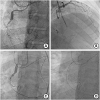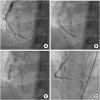This article has been
cited by other articles in ScienceCentral.
Coronary vessels distal to chronic total occlusion (CTO) are frequently accompanied by diffuse luminal narrowing induced by negative remodeling or atherosclerotic plaque. Although flow-mediated vasodilation is anticipated after effective antegrade flow restoration,
1) final vasomotor response of distal segment is often unexpected and should be considered in the stenting strategy.
A 48-year-old man, a heavy smoker with dyslipidemia and hypertension, was referred after failed percutaneous coronary intervention (PCI) of CTO in the right coronary artery (
Figure 1A). CTO-PCI was attempted via primary retrograde approach through a septal collateral because of ambiguous proximal cap (
Figure 1B-D). PCI was successful with two drug-eluting stent implantation, 4.0×22 and 3.5×38 mm, in the middle segment (
Figure 2A-C). Diffuse luminal narrowing at the distal bed persisted after flow restoration and repeated intracoronary nitroglycerin administrations (
Figure 2D,
Supplementary Video 1). Angiographic follow-up at 9 months showed significant improvement in the whole distal bed diameter with unexpected “true” tight stenoses within the enlarged vessel (
Figure 3A,
Supplementary Video 2). These lesions were successfully treated with another 3.5×30 mm stent (
Figure 3B,
Supplementary Video 3).
The treatment strategy has been inconsistent for luminal narrowing distal to CTO lesion, which undergoes variable degrees of diameter improvement after successful CTO recanalization.
2) Predicting the original distal bed vessel size or differentiating the vessel shrinkage and plaque burden contribution to luminal narrowing is difficult owing to limited practical methods,
3) watchful waiting with follow-up angiography is a reasonable strategy to decide the final treatment for such lesions.







 PDF
PDF ePub
ePub Citation
Citation Print
Print



 XML Download
XML Download